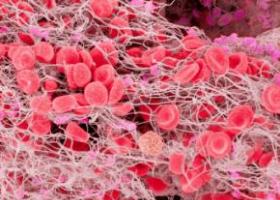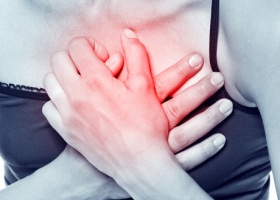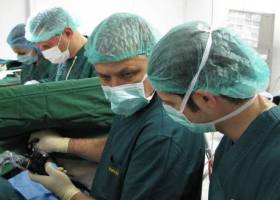January 25, 2012
- Reviews Norkolute endometriosis
- Dermovate merhem
- Instructions for use Femoden
- Visanne
Hyperthyroidism - A condition which is characterized by excessive secretion of thyroid hormone, a group of diseases caused by the body. This causes acceleration of the body and related complications. Hyperthyroidism - The presence of excess thyroid hormone, can be caused by hyperthyroidism Or other diseases of the thyroid gland - thyroiditis . nodular goiter . Graves' disease .
Increased production and accumulation in the body of the thyroid hormones in 70-80% of cases associated with increased activity of the thyroid gland at von Basedow disease, Graves' or called diffuse toxic goiter . Also, the reason can be a node or multinodular goiter. Seals thyroid as nodes provoke an increase in activity of the organ.
Causes of hyperthyroidism can also be transferred as a result of inflammation of the prostate viral infections - subacute thyroiditis As well as hyperthyroidism causes a large amount of drugs containing thyroid hormones .
In hyperthyroidism increased tissue oxygen consumption, it increases the formation of heat and accelerates energy metabolism. Tissue sensitivity to sympathetic stimulation and catecholamines increases.
Hyperthyroidism provokes increasing ratio estrogen to androgens . This is due to the increased conversion of androgens to estrogens, increasing content circulation globulin That with normal sex hormone binding. Condition causes men gynecomastia .
Also under the influence of thyroid hormone is destroyed Cortisone Which leads to adrenal insufficiency . It is promoted and the accompanying autoimmune diseases , Women are more prone to illness.
Prevention of hyperthyroidism often neglected, thus burdening the overall picture of the disease. Improper diet, lack of physical activity and other factors lead to diseases of the thyroid gland.
In the course of the disease, there are three forms: mild . moderate severity and heavy . The latter form of the disease occurs when the wrong treatment or prolonged his absence. The most common complication of hyperthyroidism occur in severe illness.
Symptoms of hyperthyroidism
Hyperthyroidism causes disruptions to many organs and systems. Excess levels of hormones causes the body to adjust to this mode of operation, thus violating many processes. Symptoms of hyperthyroidism are many changes, both internal and external.
External changes primarily noticeable as the skin. In patients with increased sweating, skin moist in the form of thin, fine hair. The nails of the patient is also amenable to change, there is a painful detachment of the nail plate. Signs of violations is also exophthalmos , There is an increase in the external eye crack and the eyeballs, eyes are bulging. Appears swelling and hyperpigmentation century .
On the part of the cardiovascular system may develop heart failure as the heart can not cope with the volume of blood supply to organs and tissues, to accelerate its work. Observed symptoms of hyperthyroidism such as the hypertension . tachycardia . increased heart rate . The respiratory system appears breathlessness Reduced lung capacity.
In mild to moderate disease progression in patients often increased appetite, severe course contrary characterized by its absence. Body weight is reduced, accompanied by nausea, vomiting, diarrhea . Violations of the musculoskeletal system lead to the development osteoporosis Reduced bone mass, there is a disruption in the structure of bones. Potassium accumulates in bones that enhances reflexes thereby impaired motor activity. Signs disorders are fatigue and muscle fast tremor . Patients have increased excitability, nervousness, frequent insomnia. They were overwhelmed with fear and anxiety, increased intelligence and speech activity.
With the genitourinary system observed frequent urination . In women is a violation of the monthly menstrual cycle. Menses accompanied by severe pain, scanty secretions, nausea and vomiting. There is a general weakness, headache and fever. In men, in turn, reduces the potency is increased and the mammary glands. Disturbances in the reproductive system are related to improper production of sex hormones, which often leads to infertility , Both women and men.
Because of disturbances in metabolism that causes hyperthyroidism, patients may form thyrogenous diabetes . Increased glucose, are frequent fever.
In less severe hyperthyroidism observed moderate weight loss, tachycardia within 100 beats per minute, there is no violation in the gland itself apart from the thyroid gland. For the average severity of hyperthyroidism is characterized by a pronounced weight loss, tachycardia in the range of 100-120 beats per minute, short-term changes in heart rate. Observed gastrointestinal disorders, disorders of carbohydrate metabolism, lowering blood cholesterol levels. Gradually growing signs of adrenal insufficiency. Severe hyperthyroidism include virtually all of the above symptoms.
Diagnosis of hyperthyroidism
Suspicion of hyperthyroidism and diagnosis occur in the presence of clinical manifestations. The appearance of the patient and laboratory data are reason enough for a diagnosis of hyperthyroidism. First of all determine the presence of high blood levels of thyroid hormones.
Diagnosis of hyperthyroidism also includes ultrasound of the thyroid gland. This makes it possible to determine the presence of nodules in the body and install the illness which caused hyperthyroidism. Appointed as an electrocardiogram to determine violations of the cardiovascular system caused by hyperthyroidism.
Often, when necessary, designate computed tomography , Layered images of the thyroid gland can detect the exact location of seals. On the basis of these indications endocrinologist appoints the course of treatment.
From laboratory tests appointed general blood analysis As well as analysis on the hormone content. When the diagnosis play an important role data on past illnesses, especially those which employ surgery. It is also important to know which drugs are taken ill or receives at the moment. It is mandatory to complete a medical examination is appointed.
Treatment of hyperthyroidism
In the treatment of hyperthyroidism, an integrated approach is assigned diet, hydrotherapy and other physiotherapy . The patient should be monitored carefully endocrinologist. Treatment of hyperthyroidism in the early stages of lung has a more favorable prognosis, reduce the risk of serious violations in the work of other organs and complications of hyperthyroidism advance cropped.
Practiced Three methods of treatment of hyperthyroidism On the choice of method is influenced by many factors. As a rule, the main indicators are the patient's age, type of violation, the current form of hyperthyroidism, presence allergic reactions to medication drugs , Co-morbidities.
Conservative treatment hyperthyroidism more effectively at an early stage of development of hyperthyroidism. This method is aimed at reducing the activity of the thyroid gland and the production of hormones. Appointed antithyroid drugs They prevent entry and accumulation in the thyroid gland Iodine , Due to which thyroid hormones are produced. Thus, the work of the gland slows down considerably.
Surgical treatment It is used in the presence of iron in a single node causing its increased activity. Also, surgery is indicated in a separate section of Pumping thyroid. When you remove a small portion of the prostate tissue of its normal work, further functioning quite stable. If diagnostic data indicate growth of large area or multinodular goiter, surgery is contraindicated otherwise develop hypothyroidism - The state of the opposite hyperthyroidism.
Along with the traditional methods of treatment used alternative method . Treatment of hyperthyroidism radioiodine . Radioiodine therapy is the single dose capsules or an aqueous solution in the content, which has a radioactive iodine. Since the drug reaches the bloodstream thyroid cells have the greatest activity and accumulates therein gradually damaging cells. The process takes place for a couple of weeks. Under the influence of radioactive iodine for thyroid size is significantly reduced, respectively, decreases its activity, and levels of hormones in the blood drops to normal levels.
Treatment of radioiodine therapy does not guarantee full recovery in some cases, a second drug. A side effect of radioactive iodine development of hypothyroidism. In such a case requires replacement therapy, which lasts for the entire life of the patient. Prescribe drugs containing thyroid hormones, their daily use makes it possible to maintain a normal level of hormones in the body.
Complications Hyperthyroidism
If untreated, hyperthyroidism or severe course there is a risk of complications. Most often it is thyrotoxic crisis As a rule, there is a crisis with severe concomitant diseases or untreated Grave's disease . When tireotoksicheskom Stroke sharply increasing signs of hyperthyroidism, aggravated symptoms booming violations in the work of other bodies. The most common complication occurs in women in 70% of cases of acute crisis develops into a severe form.
Prevention of hyperthyroidism
For the prevention of hyperthyroidism should undergo regular check-ups by an endocrinologist. The favorable impact on the strengthening of the thyroid gland is hardening. The diet should be rich in vitamins and minerals. It is reasonable to control the intake of iodine, the use of iodine-containing foods should be balanced. Died be taken and sunbathing, sunbathe, visit the solarium. Often myths about the usefulness of certain procedures and products lead to disturbances in the functioning of the thyroid gland, which have serious consequences.
 Pulmonary embolism (a shortened version - PE) - a pathological condition in which blood clots rapidly clog branch pulmonary embolism . Blood clots in the veins occur initially systemic circulation rights.
Pulmonary embolism (a shortened version - PE) - a pathological condition in which blood clots rapidly clog branch pulmonary embolism . Blood clots in the veins occur initially systemic circulation rights.  Experts identify three types of PE, regardless of how much of the pulmonary vascular lesions observed. With massive pulmonary embolism more than 50% of affected lung vessels. In this case, the symptoms of thromboembolism expressed shock, a sharp fall Blood Pressure , Loss of consciousness, there is a lack of right ventricular function. The consequence of hypoxic brain with massive embolism are sometimes brain damage.
Experts identify three types of PE, regardless of how much of the pulmonary vascular lesions observed. With massive pulmonary embolism more than 50% of affected lung vessels. In this case, the symptoms of thromboembolism expressed shock, a sharp fall Blood Pressure , Loss of consciousness, there is a lack of right ventricular function. The consequence of hypoxic brain with massive embolism are sometimes brain damage.  In the process of diagnostics performed a physical examination of the patient to identify specific clinical syndromes. The doctor can determine wheezing, hypotension, determines the body temperature, which rises in the early hours of the development of PE.
In the process of diagnostics performed a physical examination of the patient to identify specific clinical syndromes. The doctor can determine wheezing, hypotension, determines the body temperature, which rises in the early hours of the development of PE.  If there are no contraindications, treatment Heparin begin immediately after having been diagnosed. Doses should be adjusted individually. Therapy continues appointment anticoagulants . The preparation warfarin patients shown to take at least three months.
If there are no contraindications, treatment Heparin begin immediately after having been diagnosed. Doses should be adjusted individually. Therapy continues appointment anticoagulants . The preparation warfarin patients shown to take at least three months.